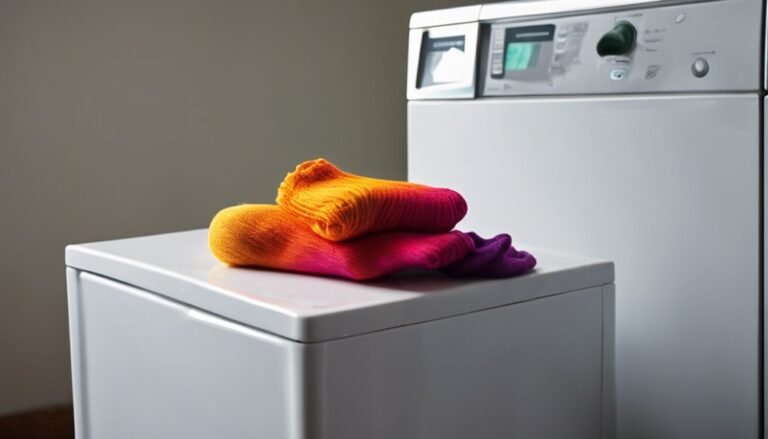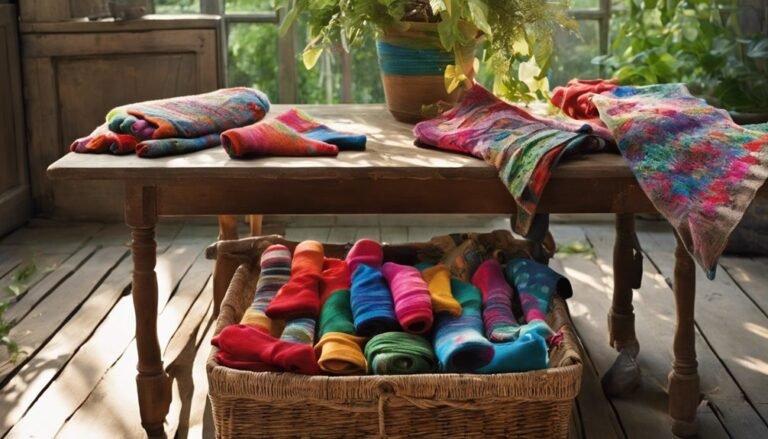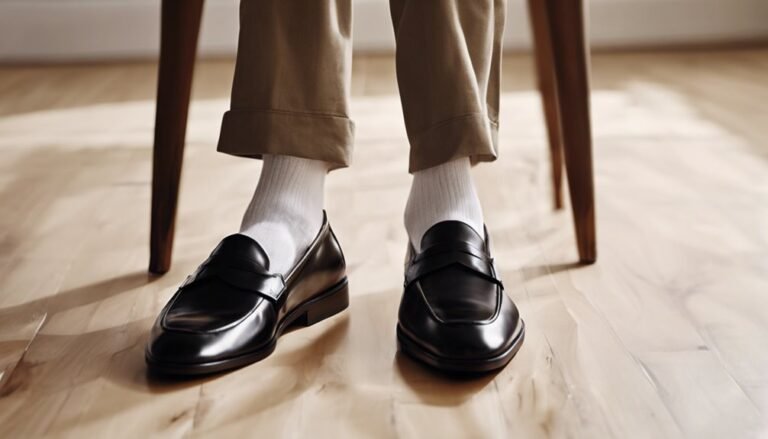Eco-Friendly Socks vs. Fast Fashion Socks: Why It Matters?
Choosing eco-friendly socks over fast fashion is essential for both the planet and ethical labor practices. Fast fashion socks contribute to pollution and exploit workers in unsafe conditions. On the other hand, eco-friendly socks use sustainable materials like organic cotton and bamboo, reducing waste and carbon emissions. By opting for sustainable alternatives, you not only support healthier production methods but also promote ethical consumerism. Discover more about the impact of your choices and how to make a difference.
The Environmental Impact of Fast Fashion Socks

While you might think that a simple pair of socks doesn't contribute much to environmental issues, fast fashion socks actually have a significant impact. The production processes behind these socks often involve unsustainable practices, like excessive water usage and toxic dyes. This not only harms our planet but also the workers involved in their creation. By opting for socks made through sustainable production methods, you can help reduce environmental harm. Increasing consumer awareness about the true cost of fast fashion is essential. When you choose eco-friendly options, you're not just making a fashion statement; you're advocating for a healthier planet. So next time you shop for socks, consider the broader implications of your choices and support brands that prioritize sustainability.
Understanding Eco-Friendly Materials
When choosing eco-friendly socks, it's crucial to understand the sustainable fabric options available. These materials not only reduce environmental impact but also enhance durability and longevity, making them a smart choice for your wardrobe. By opting for eco-friendly socks, you're supporting a more responsible fashion industry while enjoying quality products.
Sustainable Fabric Options
As you explore sustainable fabric options for eco-friendly socks, you'll discover a variety of materials that not only minimize environmental impact but also provide comfort and durability. Organic cotton is a popular choice, grown without harmful pesticides, while recycled fibers help divert waste from landfills. Bamboo fabric offers a soft touch and natural moisture-wicking properties, and hemp textiles are known for their strength and biodegradability. These options often utilize low impact dyes to reduce pollution. Performance fabrics made from these materials can keep up with your active lifestyle, all while ensuring ethical sourcing. By choosing biodegradable materials, you're not just getting socks; you're making a statement about sustainability and freedom from fast fashion's grasp.
Impact on Environment
The impact of eco-friendly materials on the environment is profound, especially when you consider their role in reducing waste and pollution. By choosing socks made from sustainable materials, you're not just making a fashion statement; you're actively participating in sustainable practices that help combat textile waste. Traditional fast fashion contributes enormously to pollution and landfill overflow, often using harmful chemicals and non-biodegradable fabrics. In contrast, eco-friendly socks are crafted from organic cotton, bamboo, or recycled fibers, which greatly lower their environmental footprint. This means less water usage, reduced carbon emissions, and a healthier planet for future generations. When you opt for eco-friendly options, you're embracing a lifestyle that promotes environmental responsibility and encourages a shift away from wasteful consumption.
Durability and Longevity
Eco-friendly socks are not only a sustainable choice but also a demonstration of durability and longevity. Made from organic materials like bamboo or recycled fibers, these socks often boast a superior sock lifespan compared to fast fashion alternatives. You'll find that their natural properties enhance wear resistance, meaning they hold up better against daily use and washing. While fast fashion socks might fray or lose shape quickly, eco-friendly options maintain their form and comfort longer, saving you money in the long run. By choosing durable socks, you're not just making a style statement; you're investing in quality that aligns with your values of freedom and sustainability. Embrace the longevity of eco-friendly socks and step confidently into a greener future!
The Social Cost of Sock Production
While you might not think twice about the socks you choose, the social cost of sock production reveals a complex web of issues that impact communities worldwide. Many fast fashion socks are produced under conditions rife with labor exploitation, where workers often endure long hours, inadequate pay, and unsafe environments. This lack of supply chain transparency makes it difficult to trace the origins of your socks, allowing these injustices to persist unchecked. By understanding the social implications behind your choices, you can become an informed consumer. Every time you buy a pair of socks, you're not just making a fashion statement; you're also voting with your wallet for the kind of world you want to support. Choose wisely!
Benefits of Choosing Sustainable Socks

Choosing sustainable socks can considerably reduce your environmental impact, making a positive difference for the planet. Plus, these socks are often made under ethical labor practices, ensuring fair treatment for workers. You'll also appreciate their long-lasting quality, which means you won't have to replace them as often, saving you money in the long run.
Environmental Impact Reduction
If you're looking to make a positive change in your wardrobe, opting for sustainable socks can markedly reduce your environmental footprint. By choosing eco-friendly options, you're not just enhancing your style; you're also contributing to a healthier planet. Here are some benefits of sustainable socks:
- Lower Carbon Footprint: Sustainable materials often require less energy and resources to produce, minimizing your overall impact.
- Biodegradable Options: Many eco-friendly socks are made from biodegradable materials, ensuring they don't linger in landfills for years.
- Support for Sustainable Practices: By purchasing sustainable socks, you encourage brands to adopt more environmentally friendly practices.
Making this simple switch can lead to lasting positive change, allowing you to feel good about your choices while enjoying stylish comfort.
Ethical Labor Practices
Sustainable socks not only benefit the environment but also promote ethical labor practices. When you choose eco-friendly options, you support brands committed to fair wages and worker rights. These companies guarantee that their workers are treated with dignity and respect, creating a positive impact on communities.
| Aspect | Sustainable Socks | Fast Fashion Socks |
|---|---|---|
| Labor Practices | Ethical, fair wages | Often exploitative |
| Worker Rights | Advocates for safety & rights | Minimal protections |
| Community Impact | Supports local economies | Contributes to poverty |
Long-lasting Quality Materials
When it comes to socks, opting for eco-friendly options means you'll enjoy long-lasting quality materials that stand the test of time. By choosing sustainable socks, you're investing in material durability and comfort that outlasts fast fashion alternatives. Here's why it matters:
- Sustainable Sourcing: Eco-friendly socks are made from organic or recycled materials, reducing environmental impact.
- Higher Quality: These socks often use superior craftsmanship, ensuring they resist wear and tear longer than their fast fashion counterparts.
- Cost-Effective: While they might cost more upfront, their durability means you won't be replacing them as often, saving you money in the long run.
How to Identify Eco-Friendly Sock Brands
How can you tell which sock brands truly prioritize eco-friendliness? Start by checking for brand certifications like GOTS or OEKO-TEX, which guarantee sustainable practices. Next, investigate their material sourcing; eco-friendly brands often use organic cotton, bamboo, or recycled fibers.
Here's a quick reference to help you:
| Certification | Meaning | Material Sourcing |
|---|---|---|
| GOTS | Global Organic Textile Standard | Organic and sustainable materials |
| OEKO-TEX | Safety for textiles | Non-toxic and safe materials |
| Fair Trade | Ethical labor practices | Sourced from fair-trade suppliers |
The Role of Consumers in Promoting Sustainability
While many consumers may not realize their power, the choices you make daily greatly impact sustainability in the fashion industry. By embracing consumer awareness and practicing responsible purchasing, you can drive significant change. Here are three ways to make a difference:
- Educate Yourself: Research brands and their sustainability practices. Knowledge empowers you to choose wisely.
- Support Eco-Friendly Brands: Prioritize companies that prioritize the environment. Your money speaks volumes.
- Advocate for Change: Share your findings with friends and family. Raising awareness creates a ripple effect.
Making the Switch: Tips for Transitioning to Eco-Friendly Socks

Shifting towards eco-friendly socks can be a rewarding step in your journey toward sustainable fashion. Start by exploring brands committed to ethical practices—look for materials like organic cotton or bamboo. Engage in sock swapping with friends to refresh your collection without buying new. This not only reduces waste but also fosters community spirit. When you do shop, practice mindful purchasing; prioritize quality over quantity, ensuring your socks last longer. Check for certifications that verify sustainable production processes. Ultimately, educate yourself about the impact of fast fashion—awareness can empower you to make better choices. By making these simple changes, you'll not only enhance your wardrobe but also contribute to a healthier planet. Embrace the freedom that eco-friendly fashion brings!
Frequently Asked Questions
How Do Eco-Friendly Socks Compare in Price to Fast Fashion Socks?
Did you know that eco-friendly socks can cost about 20% more than fast fashion socks? That's often due to sustainable materials and ethical manufacturing. However, investing in quality can save you money in the long run.
Are There Any Certifications for Eco-Friendly Sock Brands?
Yes, there are sustainability certifications for eco-friendly sock brands. Look for labels like GOTS, which guarantees organic materials, or OEKO-TEX, indicating no harmful substances. These certifications help you choose responsibly made, eco-conscious products.
Can Eco-Friendly Socks Be Recycled or Composted?
Think of your socks as part of a sustainable journey. Many eco-friendly socks, made from sustainable materials, can indeed be recycled or composted, contributing to waste reduction and allowing you to tread lightly on the earth.
What Are the Best Practices for Washing Eco-Friendly Socks?
To care for your eco-friendly socks, use cold water for sustainable laundering, avoid harsh detergents, and air dry when possible. This helps maintain their quality and extend their lifespan while being gentle on the planet.
Do Eco-Friendly Socks Offer the Same Durability as Fast Fashion Options?
When comparing durability, eco-friendly socks often stand strong due to superior material quality. While fast fashion options may seem sturdy, they can't always match the long-lasting comfort and resilience of sustainably made socks.







